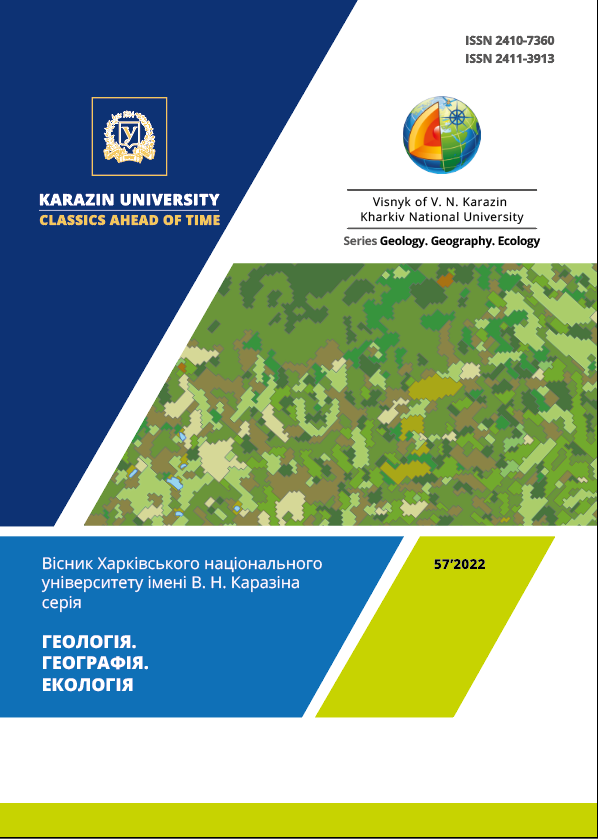Ukrainians in Slovakia: settlement and language
Abstract
Problem formulation. The Ukrainian diaspora is an important object for geographical research. Features of ethnic composition of the country of residence, its language and religious composition, age structure of Ukrainians straight affect to the processes of assimilation and preservation of ethnic identity.
The purpose of the study is to analyze and process population censuses data, which had conducted in Slovakia in 1991, 2001 and 2011.
Methodology and materials. We found the materials necessary for our article in the public domain on the website of the Department of Statistics of the Slovak Republic and on the resource “Population statistics of Eastern Europe & former USSR”. To analyze the ethnic and linguistic environment in which Ukrainians live, in study used calculations of indices of ethnic and linguistic diversity, the coefficient of ethnic compactness.
Results. According to population censuses, which had been conducted in Slovakia after 1980, the number of Ukrainians is declining. At the same time, the number of Ruthenians is growing, some of whom do not identify themselves as part of the Ukrainian ethnic group. Ukrainians live compactly in Presov and Kosice regions. In particular, these are the northern and eastern counties of the country, such as Presov, Snina, Humenne, Bardiiv, Svidnik, Mikhailovtse, Medzhilabortse and others. Ruthenians and Ukrainians are fourth and sixth largest ethnic groups in Slovakia. The country is relatively homogeneous in ethnic composition, as evidenced by the value of the index of ethnic diversity, which in most districts does not exceed 30%. However, in those districts where Hungarians, Ukrainians and Ruthenians live compactly, this value can be over 60%. Often in the process of ethnic and linguistic assimilation, belonging to a certain religion (denomination) is preserved. In terms of counties, the largest centers where Greek Catholics and Orthodox live coincide with the settlement of Ukrainians and Ruthenians. If Ukrainians and Ruthenians together do not make up 1% of the total population, the share of Greek Catholics and Orthodox in the population is almost 5%. The indicators of linguistic diversity according to the criteria of “native language” and “language of communication at work” are clearly correlated with the index of ethnic diversity. That is, on the one hand, it reflects the clear links between "ethnicity and language", and on the other – the language policy of the country, where Slovak predominates in all areas.
Scientific novelty. The index of ethnic and linguistic diversity in terms of settlements and counties of Slovakia has been determined. According to the determinate indices and the main results of the census, a number of thematic maps were prepared with the help of GIS, which reflect the settlement of Ukrainians and Ruthenians, indices of ethnic and linguistic diversity and the share of Greek Catholics and Orthodox in the population.
Practical meaninig. The obtained results and thematic maps can be useful in further research of Ukrainians living in Slovakia for historians, demographers, linguists, ethnologists, etc.
Downloads
References
Hychka, N. (2010). Rusynism in the Slovak Republic: the point of view of Slovak authors. Scientific Bulletin of Uzhgorod University. Series: Political Science, Sociology, Philosophy. 14. 168–170.
Dnistrianskyi, M. S. (2008). Ethnogeography of Ukraine. Lviv: Lviv University Pub., 232.
Ethnic composition of the population of Slovakia according to the 1980 census / http://pop-stat.mashke.org/slovakia-ethnic1980.htm
Ethnic composition of the population of Slovakia according to the 1991 census / http://pop-stat.mashke.org/slovakia-ethnic1991.htm
Ethnic composition of the population of Slovakia according to the 2001 census / http://pop-stat.mashke.org/slovakia-ethnic2001.htm
Ethnic composition of the population of Slovakia according to the 2011 census / http://pop-stat.mashke.org/slovakia-ethnic2011c.htm
Kichera, N. (2021). Ukrainian community in the Slovak Republic. Ukrainian Communities abroad: New reference points: proceedings of the International Scientific and Practical conference (Lviv, April 22, 2021) (83–87). Lviv.
Confessional composition of the population of Slovakia according to the 1991 census / http://pop-stat.mashke.org/slovakia-religion1991new.htm
Confessional composition of the population of Slovakia according to the 2001 census / http://pop-stat.mashke.org/slovakia-religion-loc2001.htm
Confessional composition of the population of Slovakia according to the 2011 census / http://pop-stat.mashke.org/slovakia-religion-loc2011.htm
Lozynskyi, R. M. (2008). Language situation in Ukraine. Lviv: Lviv University Pub., 502.
Semeniuk, S. (2007). Ukrainian guide to Slovakia (historical and local lore essays). Lviv: Apriori. 348.
Sopolyha, M. (2013). On issues of ethnic identification and modern ethnic processes of Ukrainians in Presov re-gion. Ruthenian-Ukrainians: ethnolinguistic and ethnocultural processes in historical development. 454–488.
Sopolyha, M. (2013). On the problem of ethnogenesis of the Ukrainian minority in Slovakia. Ruthenian-Ukrainians: ethnolinguistic and ethnocultural processes in historical development. 351–372.
Sopolyha, M. (2011). Ukrainians of Slovakia: material manifestations of folk culture and art. Kyiv: Tempora. 336.
Troshchynsky, V. P. (1999). Ukrainians in the world. Kyiv: Alternatives. 352.
Ruthenian-Ukrainians: ethnolinguistic and ethnocultural processes in historical development / compiled by G. Skrypnyk. Kyiv: NAN Ukrainy, MAU, IMFE im. M. T. Rylskoho. 777.
Meyer Ph., McIntosh Sh. (1992). The USA today index of ethnic diversity. International Journal of Public Opinion Research, 4, 1. 5158. https://doi.org/10.1093/ijpor/4.1.51
Population statistics of Eastern Europe & former USSR / http://pop-stat.mashke.org
Statistical office of the Slovak Respublic. The 2011 Population and housing census / http://surl.li/asfrl
Constitution of the Slovak Republic / http://www.slpk.sk/dokumenty/ustava.pdf.





